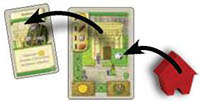
Red and Purple Character Cards
Each player begins the game with the same set of these 8 Character cards. These cards allow you to perform the necessary basic actions in the game.
Most of the other Character cards acquired during the game allow you to perform more powerful actions; however, they are all based on the basic set of actions.
Shopkeeper, Lumberjack, Stone Sculpter and Brick Worker

When you play one of these 4 cards, you take exactly 1 of the specified goods from the general supply and place it your personal supply.
Example: Red plays the Lumberjack and takes 1 Wood.
Maid
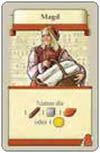
Choose any one of the 4 goods (Wood, Stone, Brick, or Gold), take 1 of that good from the general supply and place it your personal supply.
Example: Red plays the Maid, chooses Gold, and takes 1 Gold token.
Builder
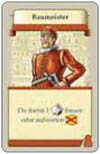
You may either build a new building in Valletta or upgrade one of your existing buildings. \The building colors are not related to the player colors; any player may build buildings of any color.
To build a new building, perform the following 4 steps:
-
Choose a Building card that does not yet have a House on it.
-
Pay the construction costs from your personal goods supply, as indicated in the upper left corner of the Building card.
-
Take the Character card from the Building card and add it to your hand. This is the main way that players will be acquiring new Character cards. This Character is now part of your card deck.
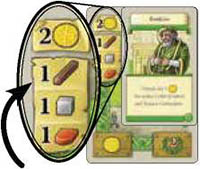
Construction costs
There is no House on this building, so it may be built.
Note: When building a new building, you may have more than 2 cards in your hand at the end of your turn. Remember that you always refill your hand to 5 cards maximum (except when not possible during the final phase).
-
Finally, place one of your wooden Houses on the square box on the Building card, to indicate that this building now belongs to you.
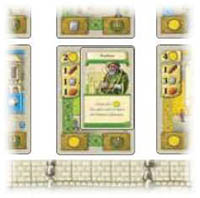
Example: Red would like to build the building shown at left. There is not yet a House on this building, so he plays the Builder.
The construction costs are 2 Gold, 1 Wood, 1 Stone and 1 Brick. Red pays these costs to the general supply.
He then takes the Banker card into his hand and places one of his Houses on the Building card.
An upgraded building will give you a higher goods income (see the green and blue character cards) and/or additional points at the end of the game. To upgrade one of your existing buildings, perform the following 3 steps:
-
Choose one of your buildings (i.e., one that contains a House of your color) to upgrade. You cannot upgrade a building that has already been upgraded.
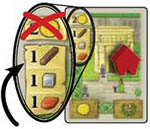
Upgrading costs
This is one of your buildings.
-
Pay the construction costs indicated. However, only pay the Wood, Stone and/or Brick shown. The upgrading of a building does not cost Gold.
-
Remove your House from the Building card, turn the Building card to its upgraded side (showing the Valletta coat-of-arms), and return your House to the Building card.

Example: Red would like to upgrade the building shown at left. (One of his Houses is already on the building to show ownership).
The upgrade costs are 1 Wood, 1 Stone, 1 Brick, but no Gold
. (You may think of the Gold as the cost to acquire the land for the building). Red pays these costs to the general supply.
He then removes his House, turns the Building card over to its upgraded side and replaces his House on the card.
Other Important Rules For Building:
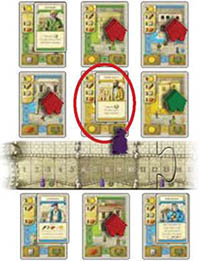
Building adjacent to other buildings
If you build a new building that is orthoganally adjacent to one or more of your own buildings, you pay 1 less Gold for each of them.
However, you never pay less than 0 Gold. Buildings on the opposite side of the Street board from each other are not considered to be adjacent.\
Example: Red would like to build the circled yellow building at right. The construction costs are 4 Gold, 3 Wood, 1 Stone and 1 Brick. |P Red has 2 orthoganally adjacent buildings. (The blue building in the upper right does not count for adjacency, since it is diagonally adjacent to the new building). The construction costs are therefore reduced by 2 Gold.
Substituting goods
When building or upgrading a building, you may substitute one or more items in the construction costs. For each item you cannot or wish not to pay, you may instead pay 3 of any other goods (same or different).
You are only allowed to make this substitution when paying goods for building or upgrading; you may not simply exchange goods to and from the supply.
Example: Red would like to build the circled building at upper right. Since he owns two adjacent building, his construction costs are reduced by 2 Gold. He doesn't own any Stone, so he may replace that cost with 2 Wood and 1 Brick. Red's total cost, therefore, is 2 Gold,
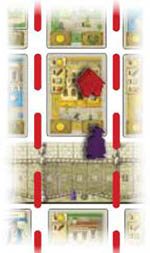
Construction bonus
Jean Parisot de Valette is overseeing the construction of buildings in Valletta, and will award a bonus of 2 points if he "sees" a player build or upgrade a building.
This occurs when the purple Jean Parisot de Valette figure is in the same area as the building being built or upgraded.
An "area" is defined by a 5-space portion of the Street board path, and all Building cards above or below thoses spaces. In the figure to the right, this area is noted by the dashed red line.
Apprentice
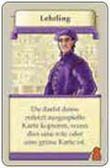
The hard-working apprentice eagerly takes on any task assigned to him-as long as that task is a specific type and has just been performed.
The Apprentice "copies" the action of a red or green Character card that has just been played as the previous card. You will usually play the Apprentice as the second or third card on your turn.
If the previously played card was red or green, the action of that Character card will be performed a second time. The Apprentice has no function if it is played as the first card on your turn, or after a card that is neither red nor green.
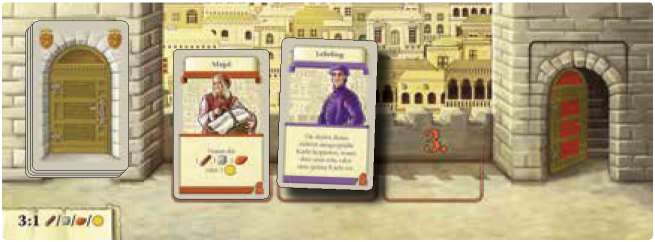
Example: You have previously played the Maid and decided to take 1 Stone. You now play the Apprentice, which allows you to take the action of the Maid once again. This time you choose to take 1 Gold.
Jean Parisot de Valette
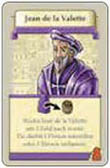
Jean Parisot de Valette was the 49th Grand Master of the Order of Malta. He commissioned the planning of the town of Valletta, laid the foundations of the city on March 28, 1566 and supervised the first construction sites.
Unfortunately, he did not live to see the completion of the city, which became the capital of Malta.
When playing Jean Parisot de Valette, you first move his figure 1 space forward on the Street board scoring path. You then reveal the Barrel tile on that space, take the good depicted on it, and return the Barrel tile to the game box.
(Should the general supply of goods become scarce during can use the discarded Barrel tiles as a substitute for the necessary goods).
You may now either dismiss a Character from your hand or hire a new Character.
To dismiss a Character, select 1 card from your hand and place it in a general Character supply stack. Important: You do not perform the action on the dismissed Character card.
To hire a new Character, you select one of the Character cards from the general Character supply stack and place it in your hand. As with building a new building, this will result in an additional card in your deck. You may hire any Character in the general Character supply stack, even a starting card from another player that they have dismissed.
Example: You play the Jean Parisot de Valette card, move him forward 1 space on the Street board scoring path, and reveal the Barrel tile from that space. The tile shows a Stone on the back. If there are no more Stones available in the general supply, you may use this Barrel tile as a temporary susstitute.
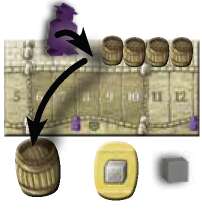
Finally, you decide to hire one of the Builders from the general Character supply stack, and add it to your hand.
Note: By dismissing Characters, it can happen that your entire Character deck contains less than 5 cards. In this case, you simply draw as many cards as possible at the end of your turns.
Note: If Jean de la Valette is already on the final space of the Street board scoring path, he does not move any further, and no additional Barrel tiles are available to take. However, you may still play his card to dismiss or hire a Character.
Green Character Cards
The green Characters allow you to gain goods, but they are usually more powerful than the red Characters described above.
Banker, Woodworker, Quarryman, Brick Maker
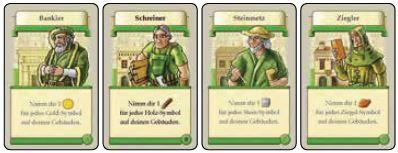
When one of these cards is played, first count the number of goods icons in the lower left corner of all buildings you own (not only green buildings) matching the Character card's good.
Only count the goods icons in the lower left corner of each card; you do not include any matching goods icons that are a part of the Building card's construction costs.
You then take that number of goods of that type from the general supply and place them in front of you.
Note: If none of your buildings show the appropriate goods icon, you do not receive any goods.
Example: Red plays a Banker. He currently owns 3 buildings showing a total of 4 Gold icons. (The building with 2 Gold icons is an upgraded building). Red takes 4 Gold and places them in his supply.
Blue Character Cards
The blue Characters offer a variety of actions, from the gaining of goods, to the construction of buildings, and even a few to annoy the other players.
Mendicant

Each of your opponents counts the total number of goods (Gold, Wood, Stone and Brick) they have in their supply. Each of them who has 4 or more total goods must choose one of them and give it to you.
No player gives up more than one good. In a 2-player game, you may also choose to take 1 good of your choice from the general supply.
Example: Red plays the Mendicant. Green has 2 Gold and 3 Wood. Since he has a total of 5 goods, he chooses to give 1 Wood to Red.
Yellow has 2 Bricks, and therefore does not give any goods to Red.
Blue has 3 Gold, 2 Wood, 3 Stone and 1 Brick. Since he has a total of 9 goods, he chooses to give 1 Stone to Red.
Bricklayer
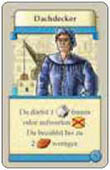
You may build or upgrade 1 building. However, the construction or upgrade costs as indicated on the Building card are reduced by 2 Bricks.
If the costs include only 0, 1 or 2 Bricks, you do not pay any Bricks. (You never take Bricks from the general supply).

Example: Red plays the Roofer and would like to upgrade this building. Upgrading does not cost any Gold. By using the Roofer, the upgrading costs are reduced by 2 Bricks.
Therefore, Red only pays 1 Stone and 1 Brick.
Trader
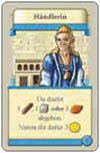
Return 1 Wood, 1 Stone, or 1 Brick to the general supply, and take 3 Gold.
Merchant
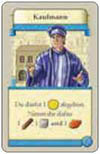
Return 1 Gold to the general supply, and take 1 Wood, 1 Stone and 1 Brick.
Treasurer
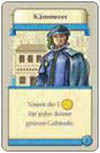
Count the number of green buildings you own (the number of green buildings with a House of your color on them).
It is irrelevant whether the building are upgraded or not, simply count them all. Then take that number of Gold from the general supply.
Stone Mason
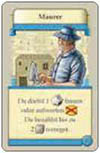
You may build or upgrade 1 building. However, the construction or upgrade costs as indicated on the Building card are reduced by 2 Stones.
If the costs include only 0, 1 or 2 Stones, you do not pay any Stones.
(You never take Stones from the general supply).
Nun
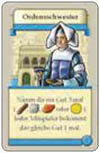
First you choose 1 of the 4 goods (Gold, Wood, Stone or Brick), and take 3 of the chosen good from the general supply.
Then, each of the other players takes 1 of that same chosen good from the general supply.
Seamstress

Take any 2 goods from the general supply.
These may be the same or different goods.
Foreman
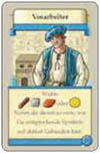
Choose one of the 4 goods. Then, just as with the green Character cards, you count how often that good is depicted on your buildings.
Take that number of goods from the general supply and place them in your supply.
Example: Red plays a Foreman and chooses Wood. He has 2 buildings that show a total of 3 Wood on them.
Red takes 3 Wood and places them in his supply.
Host
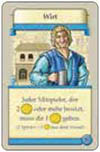
Each of the other players counts how much Gold he has. Each of them who has 2 or more total Gold must give you 1 Gold.
No player gives up more than 1 Gold. In a 2-player game, you may also choose to take 1 Gold from the general supply.
Carpenter

You may build or upgrade 1 building. However, the construction or upgrade costs as indicated on the Building card are reduced by 2 Wood.
If the costs include only 0, 1 or 2 Wood, you do not pay any Wood. (You never take Wood from the general supply).
Tax Collector
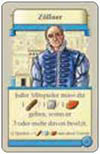
Each of the other players counts their Wood, Stone and Bricks separately. For each type of good of which he has 3 or more, each player must give you 1 of them.
It is therefore possible for a player to give you more than 1 good, but never more than 1 of the same type. The Tax Collector never takes Gold.
In a 2-player game, you may also choose to take 1 Wood, 1 Stone or 1 Brick from the general supply.
Example: In a 2-player game, Red plays the Tax Collector. Green has 5 Gold, 2 Wood, 3 Stone and 5 Brick.
Red does not get any Gold from Green, because the Tax Collector only collects the other 3 types of goods. Red does get any Wood either, because Green has only 2 Wood.
Red gets 1 Stone and 1 Brick from Green because he has at least 3 of each of those goods. Since this is a 2-player game, Red may take 1 additional good of his choice from the general supply. Red chooses to take 1 Wood.
Yellow Character Cards
The yellow Character cards represent important figures who contributed to the construction of the city of Valletta. These Character give players points throughout the game.
There are 2 copies of some of these cards, so more than 1 player may benefit from them during a game.
Of course, it is also possible for 1 player to gain both copies of the same yellow Character card by building the appropriate buildings, and thus gain that Character's benefit twice.
Architect Francesco Laparelli

This fortress architect and former student of Michaelangelo had previously supervised the construction of St. Peter's Basilica in Rome. In Valletta, he was responsible for implementing the plans of the Grand Master Jean de la Valette.
Choose Wood, Stone or Brick (you may not choose Gold). Return 4 of the chosen good to the general supply and move your Player figure forward by 4 spaces on the Street board scoring track.
Grand Bailiff Georg Schilling Von Cannstatt
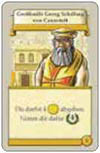
The Order of Malta was divided into individual groups, called tongues, based on the language of its members. Georg Schilling von Cannstatt presided over the German tongue.
The German-speaking Grand Bailiff was responsible for the maintenance of Malta's fortifications.
Pay exactly 4 Gold to the general supply and move your Player figure forward by 4 spaces on the Street board scoring track.
Grand Master Pietro Del Monte

Pietro del Monte was a leading member of the Order of Malta. After the death of Jean Parisot de Valette, del Monte continued the further development of Valletta as the Order's 50th Grand Master.
Pay exactly 1 Wood, 1 Stone, 1 Brick and 1 Gold to the general supply and move your Player figure forward by 5 spaces on the Street board scoring track.
Emperor Karl V
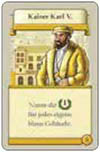
In 1530, Emperor Karl V handed over the island of Malta to the Order of St. John. During the course of the Reformation period, the Protestant section of the order split off and moved its headquarters to Germany, where it still bears the name of the Order of St. John.
The Catholic section remained in Malta and changed its name to the Order of Malta. Emperor Karl V financed the first efforts to expand Malta into a fortress for the Order.
First count the number of blue buildings you own (blue buildings containing a House in your player color). It does not matter whether these buildings are upgraded or not. Then move your Player figure forward on the Street board scoring track by that number of spaces.
King Philip II of Spain

The son of Emperor Karl V, Philip continued the support of the Order of Malta as an ardent Catholic, and strengthened the independence of the Order of Malta by conferring certain rights and privileges on the Order.
First count the number of green buildings you own (green buildings containing a House in your player color).
It does not matter whether these buildings are upgraded or not.
Then move your Player figure forward on the Street board scoring track by that number of spaces.
Pope Pius V
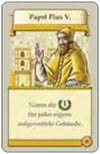
After Malta was besieged by the Ottomans in 1565, Pope Pius V sent architect Laparelli there to assess the condition of the fortifications and report back to him.
The Pope had an interest in establishing Malta as a bastion of Catholicism in the central Mediterranean.
On the basis of the report, it was decided to build a new fortified city on the peninsula of Sciberra with papal assistance. Pope Pius V is still honored in Malta today on his feast day of April 30th, even though he is also known for mercilessly persecuting other free thinkers during the Inquisition.
First count the number of upgraded buildings you own (upgraded buildings containing a House in your color).
The color of the buildings are irrelevant. Then move your Player figure forward on the Street board scoring track by that number of spaces.
Sir Hieronymus von Rekuk

The great siege of Malta in 1565 cost countless lives on both sides of the conflict. Hieronymus von Rekuk was one of the many knights who lost their lives defending the island.
However, the loss of life on the part of the Ottoman besiegers was just as significant. One of the most important questions throughout history is whether the use of warfare justifies its price.
For now, we can only hope that humanity will one day find better ways of solving conflicts... ...by playing board games, perhaps?
When you play this card, move your Player figure forward by 2 spaces on the Street board scoring track.
Continue Reading
